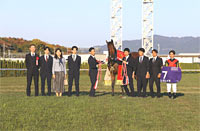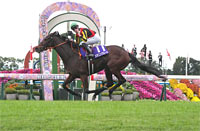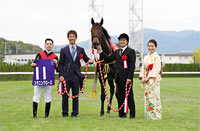Queen Elizabeth II Cup (G1) - Data Analysis
Top contest for fillies/mares that has been won by a long line of famous names
After capturing her first G1 victory in the 2018 Queen Elizabeth II Cup, Lys Gracieux won the JRA Award for Best Older Filly or Mare (4yo+) that year, and went on to also triumph in the Takarazuka Kinen in 2019. Among other winners, 2015 winner Marialite notched a win in the 2016 Takarazuka Kinen, and 2010 winner Snow Fairy triumphed in the Hong Kong Cup in her next outing. This shows that many of the past Queen Elizabeth II Cup winners have emerged as strong performers in subsequent big races against colts/horses. In addition to being the champion decider for fillies/mares, the Queen Elizabeth II Cup is also an important race that offers pointers to future success in middle- to long-distance G1 races. Let’s now analyze some features shared by successful runners in this race based on results over the last 10 years.
Focus on runners that contested a higher grade race last time out
Of the 30 Top 3 finishers over the last 10 years, 28 had contested a G1 or G2 race (including overseas) last time out. Meanwhile, runners that had contested a “race other than G1 or G2” produced zero winners and achieved a Top 3 ratio of only 3.2%. In other words, we should lower our expectations of runners that have contested a G3, open-class stakes, or allowance-class race last time out. [Table 1]
[Table 1] Performance by grade of previous race
Grade of
previous race |
Performance
[1st-2nd-3rd-4th or lower] |
Win ratio |
Top 2 ratio |
Top 3 ratio |
| G1 or G2 |
10-9-9-83 |
9.0% |
17.1% |
25.2% |
| Race other than G1 or G2 |
0-1-1-60 |
0% |
1.6% |
3.2% |
Runners that have won a G1 or G2 race since previous year are comparatively strong contenders
Of the 30 Top 3 finishers over the last 10 years, 20 had experience of winning a “JRA G1 or G2 race since the previous year.” These runners achieved a Top 3 ratio of 32.3%. In addition, 2010 winner Snow Fairy (UK-trained) also triumphed in the Epsom Oaks (G1) and Irish Oaks (G1) in the same year. It therefore seems we can place our trust in runners that have won a higher grade race since the previous year. [Table 2]
[Table 2] Performance by experience of winning “a JRA G1 or G2 race since previous year” (last 10 years)
| Win experience |
Performance
[1st-2nd-3rd-4th or lower] |
Win ratio |
Top 2 ratio |
Top 3 ratio |
| Yes |
4-8-8-42 |
6.5% |
19.4% |
32.3% |
| No |
6-2-2-101 |
5.4% |
7.2% |
9.0% |
Expect little from runners that suffered a major defeat in their previous race
Of the 30 Top 3 finishers over the last 10 years, 27 had finished in the Top 7 of their previous race. Meanwhile, runners that had finished “8th or lower” in their previous race struggled with a Top 3 ratio of only 5.9%. If we limit our analysis to the seven years from 2012, this group delivered performance of [0-0-0-30] (Top 3 ratio of 0%), with all runners being beaten to 4th or lower. In other words, we should expect little from runners that suffered a major defeat in their previous race. [Table 3]
[Table 3] Performance by finish in previous race (last 10 years)
Finish in
previous race |
Performance
[1st-2nd-3rd-4th or lower] |
Win ratio |
Top 2 ratio |
Top 3 ratio |
| 7th or higher |
9-9-9-95 |
7.4% |
14.8% |
22.1% |
| 8th or lower |
1-1-1-48 |
2.0% |
3.9% |
5.9% |
Runners aged 4 or less are strong performers
Of the 30 Top 3 finishers over the last 10 years, 24 were aged “4 or below.” Meanwhile, runners aged “5 or above” achieved a Top 3 ratio of only 7.8%, and delivered performance of [0-1-1-47] in the six years from 2013 (Top 3 ratio of 4.1%). This suggest we should focus on younger runners aged “4 or below.” [Table 4]
[Table 4] Performance by age (last 10 years)
| Age |
Performance
[1st-2nd-3rd-4th or lower] |
Win ratio |
Top 2 ratio |
Top 3 ratio |
| 4 or below |
8-7-9-72 |
8.3% |
15.6% |
25.0% |
| 5 or above |
2-3-1-71 |
2.6% |
6.5% |
7.8% |
In addition, among the six runners aged “5 or above” that finished in the Top 3, four (excluding 2009 winner Queen Spumante and runner-up T M Precure) had experience of contesting the Queen Elizabeth II Cup of the previous year, and all finished in the Top 5 of that race. In other words, we should definitely lower our expectations of runners aged 5 and above that did not make it into the top places of the Queen Elizabeth II Cup of the previous year. [Table 5]
[Table 5] Among runners aged “5 or above,” performance by experience of finishing in the Top 5 of the Queen Elizabeth II Cup of the previous year (last 10 years)
| Experience |
Performance
[1st-2nd-3rd-4th or lower] |
Win ratio |
Top 2 ratio |
Top 3 ratio |
| Yes |
1-2-1-10 |
7.1% |
21.4% |
28.6% |
| No |
1-1-0-61 |
1.6% |
3.2% |
3.2% |
Runners that contested a race of above 2,200m last time out have struggled in recent years
All of the 18 Top 3 finishers over the last six years had contested a race of 2,200m or less last time out. Up to 2012, some runners that had contested a race of above 2,200m exhibited strong performance, but if trends in recent years are anything to go by, runners that contested a race of above 2,200m such as the Kyoto Daishoten last time out are likely struggle. [Table 6]
[Table 6] Performance by distance of previous race (last 6 years)
| Distance of previous race |
Performance
[1st-2nd-3rd-4th or lower] |
Win ratio |
Top 2 ratio |
Top 3 ratio |
| 2,200m or less |
6-6-6-69 |
6.9% |
13.8% |
20.7% |
| Above 2,200m |
0-0-0-17 |
0% |
0% |
0% |
Seek out the winner!
Focus on runners with more positives
The last six winners had all contested a G1 or G2 race last time out. Other shared features among these winners were that they had finished in the Top 5 of their previous race, that they were aged 4 or less, and that they had contested a race of 2,200m or less in their last outing. In other words, any runners that clear many of the conditions in Table 1, Table 3, Table 4, and Table 6 should be regarded as leading contenders. [Table 7]
[Table 7] Winners “previous race (grade),” “finish in previous race,” “age,” and “distance of previous race” (last 6 years)
| Year |
Winner |
Previous race (grade) |
Finish in
previous race |
Age |
Distance of
previous race |
| 2013 |
Meisho Mambo |
2013 Shuka Sho (GⅠ) |
1st |
3 |
2,000m |
| 2014 |
Lachesis |
2014 All Comers (G2) |
2nd |
4 |
2,200m |
| 2015 |
Marialite |
2015 All Comers (G2) |
5th |
4 |
2,200m |
| 2016 |
Queens Ring |
2016 Fuchu Himba Stakes (G2) |
1st |
4 |
1,800m |
| 2017 |
Mozu Katchan |
2017, Shuka Sho (G1) |
3rd |
3 |
2,000m |
| 2018 |
Lys Gracieux |
2018 Fuchu Himba Stakes (G2) |
2nd |
4 |
1,800m |
(Masaya Ibuki)
|



















